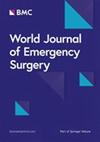Stoma reversal after emergency stoma formation—the importance of timing: a multi-centre retrospective cohort study
IF 5.8
1区 医学
Q1 EMERGENCY MEDICINE
引用次数: 0
Abstract
Restoration of intestinal continuity is a key consideration for patients having a stoma created under emergency conditions. There is contrasting evidence about the outcomes of stoma reversal for these patients. This research aims to describe the post-operative outcomes of stoma reversal after emergency formation, and whether these are affected by the timing of reversal. A retrospective review of a prospectively maintained emergency laparotomy (EmLap) database for 4 hospitals was performed between 2018 and 2021. Adult patients undergoing emergency stoma formation were identified and followed up until 2024. Those undergoing stoma reversal surgery were included in the final analysis. A Cox proportional-hazards model was created to identify factors associated with increased time to reversal. 1775 patients had an EmLap, with 505 (28.5%) having a stoma created. Of those patients with a stoma, 97 patients (19.2%) died within one year post-operatively. 146 (28.9%) of the emergency stoma patients underwent stoma reversal, with median time to reversal of 16.9 months. Median post-operative length of stay was 7 days, and 52.1% of patients sustained complications within 30 days post-operatively. Patients reversed within 18 months of stoma formation had fewer significant complications (7.9% v 35.1%, p < 0.001), a shorter length of stay (6 days v 7 days, p < 0.001), and reduced post-operative ileus rates (21.3% v 64.9%, p < 0.001) than those reversed after this period. Receiving adjuvant therapy for malignancy (adjusted Hazard ratio 0.36, 0.17–0.78, p = 0.001) and being male (adjusted Hazard ratio 0.69, 0.49–0.97, p = 0.032) were significantly associated with increased time to reversal. Emergency stoma formation is commonly performed during EmLap, but the majority of emergency stomas are never reversed. The complication profile for reversing these stomas is significant, but early reversal is associated with better post-operative outcomes. Standards of care for emergency stoma patients would be welcome in order to improve outcomes for this cohort.紧急造口后的造口逆转——时机的重要性:一项多中心回顾性队列研究
恢复肠道连续性是在紧急情况下造口患者的关键考虑因素。关于这些患者的造口逆转的结果有不同的证据。本研究旨在描述急诊形成后造口逆转的术后结果,以及这些结果是否受到逆转时机的影响。对2018年至2021年期间4家医院前瞻性维持的急诊剖腹手术(EmLap)数据库进行回顾性审查。确定并随访急诊造口的成年患者,随访至2024年。接受造口逆转手术的患者纳入最终分析。建立了Cox比例风险模型,以确定与逆转时间增加相关的因素。1775例患者使用EmLap, 505例(28.5%)造口。在有造口的患者中,97例(19.2%)在术后一年内死亡。146例(28.9%)急诊造口患者行造口逆转,中位逆转时间为16.9个月。术后中位住院时间为7天,术后30天内出现并发症的患者占52.1%。在18个月内逆转造口的患者比在18个月内逆转造口的患者有更少的显著并发症(7.9% vs 35.1%, p < 0.001),住院时间更短(6天vs 7天,p < 0.001),术后肠梗阻发生率(21.3% vs 64.9%, p < 0.001)。接受恶性肿瘤辅助治疗(校正风险比0.36,0.17-0.78,p = 0.001)和男性(校正风险比0.69,0.49-0.97,p = 0.032)与逆转时间增加显著相关。急诊造口通常在EmLap中进行,但大多数急诊造口从未逆转。逆转这些造口的并发症是显著的,但早期逆转与更好的术后预后相关。急诊造口患者的护理标准将受到欢迎,以改善该队列的预后。
本文章由计算机程序翻译,如有差异,请以英文原文为准。
求助全文
约1分钟内获得全文
求助全文
来源期刊

World Journal of Emergency Surgery
EMERGENCY MEDICINE-SURGERY
CiteScore
14.50
自引率
5.00%
发文量
60
审稿时长
10 weeks
期刊介绍:
The World Journal of Emergency Surgery is an open access, peer-reviewed journal covering all facets of clinical and basic research in traumatic and non-traumatic emergency surgery and related fields. Topics include emergency surgery, acute care surgery, trauma surgery, intensive care, trauma management, and resuscitation, among others.
 求助内容:
求助内容: 应助结果提醒方式:
应助结果提醒方式:


